Right Around the Block
by Doug MacGillvary
Reprinted from "Crown Jewels of the Wire", May 2001, page 32
I first contacted Ron Souza in hopes of purchasing a porcelain block
insulator similar to the one Ron owns and is shown in Gerald Brown's
"Collectible Porcelain Insulators". The Pacific Pottery Company block
would fill a hole in a collection of porcelain threadless insulators that didn't
have many holes left to fill.
Ron clued me in. "Doug, those that have them
are not going to give them up. If you really want a block from the Placerville
and Humbolt line, you'll have to come out here."
John McDougald was invited
out by Ron to see first hand the areas that were being worked in search of the
somewhat controversial glass blocks.
With all of our plans made for our west
coast trip, what a surprise was in store? How about our host being rushed to the
hospital 48 hours before our departure.
These are my recollections of the trip,
written on Saturday, July 15th just before my return trip to Connecticut.
July 11th Tuesday: Hats off to America West. Plane leaves right at 7 :45 a.m.
for a perfect flight to Phoenix and then on to Sacramento. John has arrived
about one half hour before me. The decision to rent a car for our use is made.
Not much choice -- Lincoln Town Car or Blazer. Duh!?! Off to see Ron at the
hospital. Jim Sanders has come up from Ojai to spend the week with us, filling
in for ailing Ron. We do stop at Ron's house getting a chance to see some pretty
neat insulators and get a feel for the research this guy is doing. Then it's on
to Joe Sousa's (Ron's son) home in Marysville. More interesting pieces to look
at. Joe is going out with us on Friday, but right now the three of us head for
the mountains, specifically the Plumas National Forest at LaPorte. We camp out
under the stars. Chilly sleeping on a cot and not the best night's sleep.
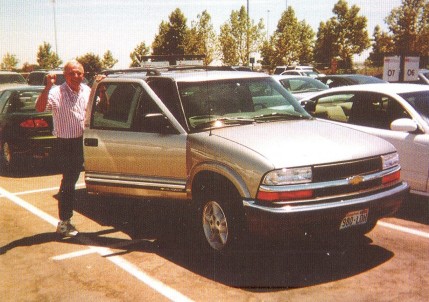
I'm ready to go ... Blazer and all!
July 12th Wednesday: Metal detectors and three pronged rakes in hand, it's off to the somewhat allusive telegraph lines. Not fully
understanding the many lines that might have connected the mining settlements,
we spent a lot of time on a portion of a line that has yielded glass blocks. We
did find good traces of wire to indicate direction, but no span locations. A lot
of time is spent combing areas to pick up wire location. This is very rugged
terrain and to think this is a simple task is to be very naive. At noon we drove back
to LaPorte and had a sandwich at the Rabbit Creek Deli, one of two businesses in
town, the other being the Union Hotel.
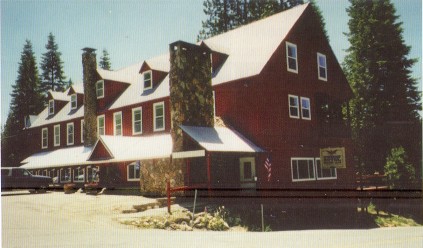
Only bed in town -- the Union Hotel.
John and I checked out the Union with the
thought of staying there for the night. Otherwise it's a bunch of miles back to
civilization. Lucky us -- a double bed and a pullout in the third floor suite
for $95.00 plus tax. We jumped on that and I believe there was only one other
room rented for the night.
It was back to the forest for a somewhat shorter
afternoon search. I guess all three of us were tired, but we worked an area
called Yankee Hill. We didn't have any luck in picking up a line location.
We
headed back to the Union and kicked back having a few beers, a good steak
dinner, a shower and a good night's sleep (much better than the camp out
routine). End of day two.
July 13th Thursday: Breakfast at 7:00 a.m. in the hotel restaurant. Special
of the House -- all you can eat sourdough pancakes and sausage for $5.00 cooked
by the hotel owner, served by his daughter. Absolutely delicious!! Chip (the
owner) makes up some ham and cheese sandwiches, adds a plate of fixin's, some
chips and we are ready for day two in Plumas. It is suspected that the line ran
from LaPorte to St. Louis (about five miles). Previously a glass block and side
bracket had been located and cut from a tree. This is a piece that we had seen at Joe Souza's home in Marysville. From that tree location
we comb the area in the direction of St. Louis. We spend about two hours and
arrive at the St. Louis cemetery. Very interesting -- everything is somewhat
overgrown but all of the headstones are still in place. All other evidence of a
community has disappeared. St. Louis at one time had about fifty buildings but
like the other mining settlements nothing remains. I mean nothing! We work our
way back across the same area still not picking up any trace of a line.
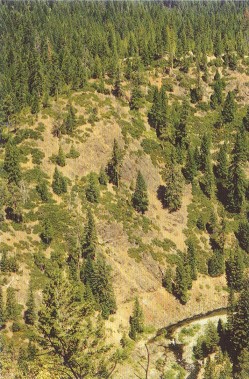
Extreme terrain in the old mining settlements.
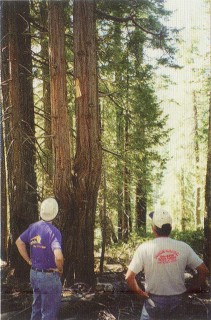
John McDougald and Jim Sanders
observe scar left by the
side bracket and
glass block.
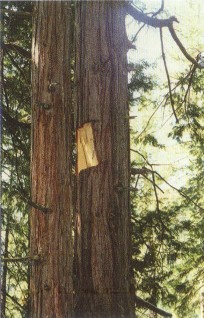
Scar about 15 feet up on
the trunk of the tree.

St. Louis remains.
It's
back to the Yankee Hill area for a new point to work from, but first lunch. Two
beers are split three ways. Jim discovers the plastic bag holding ice leaked and
those beautiful ham and cheese sandwiches become breadless. All three were
submerged in water. After consuming what was still edible we examine what looks
to be the old wheel tracks to St. Louis. The Souzas have poked around and
thought they had picked up traces of wire. We work a fairly large area, picking
up some wire. But not being able to put together anything concrete. We work our
way out to the truck and head back to Roseville.
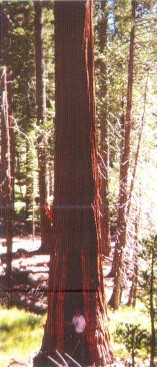
Trees big enough to swallow a man.
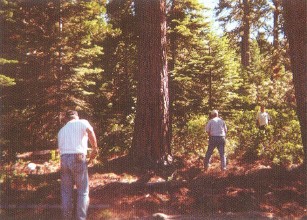
Jim Sanders and me digging under some
large cedar trees.
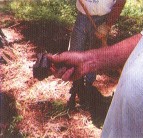
A rockem'...
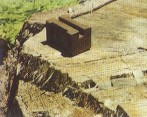
... Sockem'...

Party -- right around the block --
with me, Joe Souza and Jim Sanders.
Friday is the day I'm waiting
for: the reason I came -- the Placerville and Humbolt line -- "The Bee
Line" -- the porcelain block I want for my collection.
The trip to the
LaPorte area was great. It wasn't particularly successful and it didn't solve
all the nagging questions when new pieces surface. Believe me, looking for
insulators in the Plumas National Forest is not like looking in your backyard.
Success on the glass block lines would have been nice, but success on the Bee
Line is mandatory.
Back in Roseville we luck into a room with a bum air
conditioner for a mere $30 per night. This is such a good deal it becomes
headquarters for three nights. This really was some good luck because the
Olympic trials were being held in Sacramento and everything was booked.
We clean
up, go visit Ron, who is still in the hospital and then on to the Cattlemen
Restaurant for another round of beef. Long day -- into bed by 10:00 p.m. Joe
Souza is picking us up at 6:00 a.m.
July 14th Friday: Joe is right on time and it's off to the "Bee
Line" -- east on Route 50 toward Nevada. Ron and Joe have spent years on
this line and know where there should be some promising locations, but still
there is no guarantee that a block will show up. At the first stop, wire and
nails are picked up almost immediately around a large dead tree. The site looks
so promising that John and I start to dig an area probably 10' x 15', down to
firm ground -- nothing!
This promising start bogs down some as line location
eludes us. We work an old roadway but find almost nothing. A large cedar, about
1/4 mile from our first excavation, still has the bracket nails protruding. This is a site that Jim Sanders previously dug
with no results. John, Jim and myself expand the excavation area but still no
block in sight. The four of us work the next 1/4 miles until the old road meets
existing Highway 50.
We now head to a new location about a mile further east. It
was here that Jim and Dave Campbell recently dug a block at the base of a large
cedar. Back about 180 feet is another stately cedar, clearly scarred where a
bracket had been fastened. This sure looked like the spot that would yield the
California block that was missing from my threadless porcelain collection. John
and I worked this site as Joe and Jim started searching out line location ahead.
The area we excavated with our rakes turned up nothing. John moved ahead with
the other two, but I stayed behind and expanded thy search area. It just had to
be there, yet the time was moving along and nothing was turning up. Finally the
others returned, not finding any wire locations and I conceded that this huge
tree was not surrendering its 140 year-old insulator to this
"Easterner".
Back to Joe's Bronco and on to site number three, another
few miles down the highway. Here we pulled off onto a side road. Joe pointed out
a huge cedar with a large section of the base either rotted or burned out. When
we got close you could see where the side bracket had been. This looked as
promising as the tree I had just finished digging.
John, Jim and myself started
raking. The soil was soft down a foot or more with a heavy grass and weed
growth. This was unlike all the other digging we had done this week. We started
about twelve feet from the tree in a fan shape working toward this monster of a
cedar -- John on the left, Jim in the center and me on the right. As each foot
of earth is scraped and nothing shows up, doubt starts to set in. John and I
reach the base of the tree from the left and right -- nothing.
Jim digs to the
base at the rotted out section -- nothing. Then he takes his rake and starts to pull out the almost
sawdust-like wood and
soil that is in the tree itself. Probably two thirds of the debris is raked out
when -- KLINK! The next careful pull on the rake delivers the most beautiful
sight -- an almost perfect Pacific Pottery block! One hundred and thirty years
in the ground and now the center of attention of four very happy treasure
hunters.
Pictures are taken (all smiles, of course) and the hunt for the day
officially ends.
Back to the hospital in Roseville to show the "Bee Line
Guru" the newest addition to the insulator hobby. We were all pretty happy
campers, but I think Ron was the happiest. Even though this trip to the hospital
kept him from going on the dig, he had kept his promise to me -- "You come
out and we'll send you home with a block."
Well, John left for two
insulator events in Oregon on Saturday and Sunday. He had a six hour drive after
a whole day of insulator hunting.
July 15th Saturday: Jim and I went back up to Plumas and scouted out some
areas that might yield a telegraph line, but it wasn't the kind of day Friday
had been. We drove back to Roseville late in the afternoon. Jim dropped me off
at the motel and then headed home to Ojai, a six hour ride. A giant thanks to
Jim. He stepped in when Ron was rushed to the hospital. He led the way from
Tuesday to Saturday. What a good friend!
July 16th Sunday: America West Flight 2126 departs Sacramento at 12:13
p.m. as scheduled. On board is the first Pacific Pottery Company block to leave
the state.
|
Let's see: |
|
|
Airline Ticket
|
$418.00
|
|
Car Rental
|
$135.00
|
|
Motel
|
$95.00
|
|
Food
|
$100.00
|
|
Miscellaneous
|
$85.00
|
|
Porcelain Block & Memories
|
PRICELESS!!
|
| 